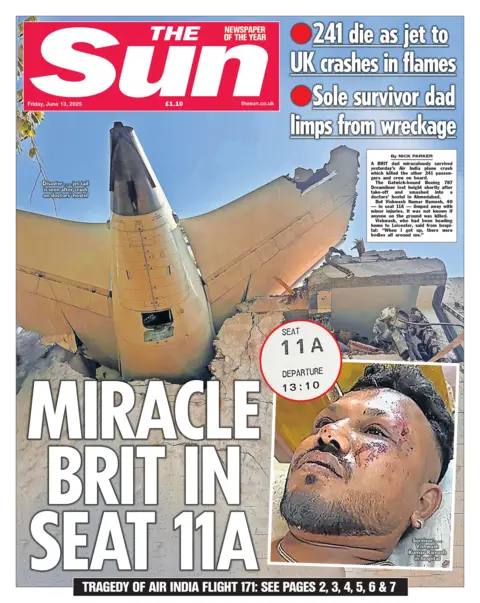The tragic crash of the London-bound Air India Flight 171 has shocked the world, capturing headlines and hearts after it was revealed that one individual emerged as the sole survivor against all odds. The crash, which occurred near Ahmedabad, India, resulted in the deaths of all other 241 passengers and crew onboard, making it one of the deadliest aviation disasters in recent history. Amidst the devastation, the remarkable survival story of Vishwash Kumar Ramesh, who occupied seat 11A, has drawn widespread attention, with many hailing it as a “miracle.”
In a dramatic turn of events, reports detail how Mr. Ramesh, a father from Leicester, survived the catastrophe that obliterated his fellow passengers. The headlines across multiple British tabloids and broadsheets emphasize the “miracle of seat 11A,” spotlighting not just Mr. Ramesh’s incredible survival but also the family members who mourn their loved ones. The Sun’s coverage is particularly poignant, headlining with “miracle Brit in seat 11A,” which resonates with readers searching for a glimmer of hope in the wake of tragedy.
Media reports indicate that this catastrophic event is the UK’s worst air disaster since the mid-1980s. The Daily Telegraph notes that out of the victims, 52 were UK nationals. Investigators are examining various potential causes for the crash, including engine failure and the possibility of a bird strike, while also scrutinizing the aircraft’s wing position. The dire nature of this incident raises urgent questions about aviation safety standards, particularly concerning the Boeing 787 Dreamliner, which had not seen a crash since it entered service in 2011.
Further emphasizing the gravity of this tragedy, the Financial Times pointed out that the repercussions of the accident would place increased scrutiny on Boeing, particularly after the company faced significant challenges following the two devastating crashes of its Boeing 737 MAX aircraft. This latest incident comes at a sensitive time for Boeing, given their ongoing efforts to restore public confidence in their aircraft.
The narratives surrounding Mr. Ramesh’s survival are profoundly moving; family members recounted how he is still grappling with the psychological effects of witnessing the event while losing loved ones. His brother was reported to have been onboard, likely among the deceased, amplifying the family’s grief. Papers like the Metro describe Mr. Ramesh as appearing “dazed and startled” as authorities led him away from the wreckage, further humanizing the account and showcasing the emotional toll of such catastrophes.
The Daily Mirror described how Mr. Ramesh emerged “against all odds” and how various papers echoed similar sentiments, demonstrating how deeply this story resonated within public consciousness. The widespread reporting on the seat number serves to highlight the randomness of survival in tragic circumstances, stirring conversations about fate and chance in dire situations.
Photographs of the crash scene and Mr. Ramesh alongside quotes detailing his disbelief about surviving the ordeal highlight the media’s role in bridging the gap between grief and hope, navigating through the raw emotions of disaster. Other papers, including the Guardian, noted that the crash resulted in a significant loss of life, with many victims being not just travelers but also individuals on the ground adversely affected by the explosion.
In conclusion, while the investigation continues into the causes and repercussions of the Air India Flight 171 disaster, one story shines through the clouds of despair: the miraculous survival of Vishwash Kumar Ramesh in seat 11A. His journey from despair to survival, coupled with the heavy losses suffered by countless families, encapsulates the complex emotional landscape that surrounds aviation tragedies, compelling society to reflect on vulnerability and resilience in the face of calamity.



